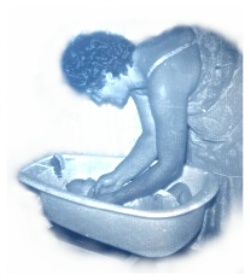 1975. The baptize ceremony of Ionel a Petrei
1975. The baptize ceremony of Ionel a Petrei
When a couple is going to have a new baby born, they look for a married
couple, usually an elder one, to serve as godparents for their baby.
Most godparents aren't choosen from close relatives, but from
the spouses's friends.
This way two friend families become relatives.
Tradition suppose that new born children's names are to be choose by godparents.
When babies can talk, they address to godparents with the name of
"nan"(godfather) or "nana" (godmother).
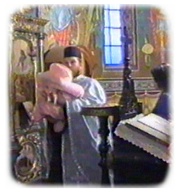 Baptize service in Negrea Church
Baptize service in Negrea Church
Fathers are those that usually declare their new born babies at the Register's Office, the first three days after babies' birth. Two months gone since women gave birth babies, priests come visiting them. Priests keep religious services in homes which are meant to purify women after child giving birth. They say that purification is extended on their children too. Once babies are ready to go outdoors, parents, godparents, relatives and friends go to church for baptizing babies. Priests make christening ceremonies, during which they bathe babies in recipients of holy water called "cristelnita" (font).

One year gone from baby's birth, godparents are invited at godsuns' homes for a ritual which is called "luatul din mot" (first haircut). Godmothers cut tresses from their godsuns' hair and hand it over to babies' mothers in order to keep it until their child will be 18 years old. Afterwords babies are offered different things with symbolical values. They say that children's careers depend on the objects they choose during "First haircut" rituals. (For ex. if they choose a pen, they will become intelectuals; if they choose a tool, they will be workers a.s.o.)
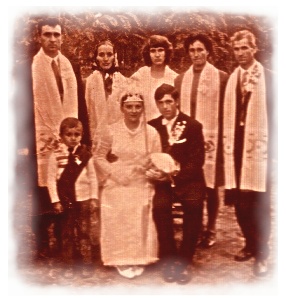
1955. Lepadatu's wedding ceremony
Sponsors' choosing
Before wedding, couple who are going to marry choose another married couple
to be their wedding sponsors.
Tradition says that their sponsors are to be counsellors for their marriage
along time.
Orthodox religion assigns sponsors the role of warrants in front of God;
therefore they've got to play an active role so as their
godsuns live in harmony ever after.
Wedding ceremonies consists of three stages which usually take place in the same day.
 1970.Sandu Sirbu from Negrea marries Gica Lepadatu from Schela
1970.Sandu Sirbu from Negrea marries Gica Lepadatu from Schela


Women dressing up the bride
Bride's dressing up
In the first stage, brides, sponsors, relatives and friends go to Town Hall. That usually happens on Saturday. One hour before leaving, in brides' homes, sponsors' wives (godmothers) dress brides up with wedding gems. Audience is exclusively formed by women (except musician, who plays accordion). This ritual is called "Gatitul miresii"(Bride's dressing up). The way brides are dressed up by sponsors' wifes is meant to suprise grooms and their processions who come to take brides to the Town Hall. Grooms arrive at brides' houses accompanyed by male wedding guests and fiddlers.
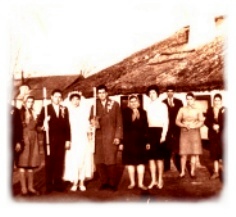 Wedding in Negrea in 1948
Wedding in Negrea in 1948
Bride and groom, sponsors and close relatives go together to the Town Hall. Procession includes shouts and car hootings in order to announce villagers that there's a wedding in the commune. Once arrived at the Town Hall, Mayor makes a formal ceremony during which he wears a tricolour banderole. Bride and groom express their wish to marry eachother then sign up in Register's Office. Sponsors sign up too, as witnesses. Mayor officially declares them husband and wife and hands them over the marriage certificate.

Close relatives only attend to wedding ceremonies at Schela Town Hall. Participants are few especially when bride and groom come from Negrea village and procession should walk a long way to Schela Register's Office just for a 15 minutes ceremony. Most relatives and friends go directly to church and wait for the just married couple to show up for the religious ceremony. Once everybody gathered in church, priest keep a service during which he reads to young couple examples and advices about marriage from the Bible. Wedding sponsors play an important role in this ceremony, as they stand next to bride and groom, in front of shrine. In Orthodox religion wedding sponsors are considered to be spiritual parents of marriages they wed.
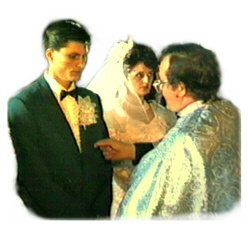
Schela's priest solemnizing a wedding
When religious wedding ceremony comes to end, wedding guests go home and rest for couple houres. They must be fresh for the wedding party which usually begins after 8 o'clock in the evening. Invitations having been made orrally, bride and groom already know number of guests at their wedding party. They ask two unmarried teens (boy and girl) among their guests to be their best man and best lady. Best man and best lady doesn't play the same role as in Catholic wedding ceremonies. In Romanian Orthodox tradition best man and best lady receive guests at the entrance of wedding party premises. They welcome guests and put them small white flowers on the lapel of their clothing.
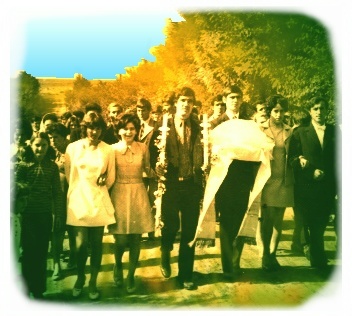
1960. Just married couple Iacob returning from church

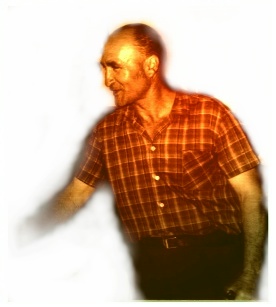 Cernat Gheorghe inviting his guests at wedding party, as father-in-law
Cernat Gheorghe inviting his guests at wedding party, as father-in-law
Last stage of weddings are wedding parties. They usually start up after 8 p.m. and last until morning. Wedding parties are held either in parents-in-law's courtyards or in special premises in the villages: the Wedding house in Schela village or the Cultural Club in Negrea village. Although parents-in-law pay all wedding party costs, sponsors are in charge with party's management. Sponsors have to make sure everybody is pleased with food, drinks, music and services, because in the end of parties sponsors are those who are to collect money from guests for just married couples.
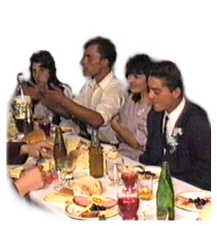
Guests enjoying a wedding party
There are some Romanian traditional dishes always served at wedding parties:
* entree (cottage cheese, meat balls and olives)
* force-meat rolls (in cabbage or vine leaves)
* roast pork or chiken
People usually drink "tuica" (house-made brandy) and red pure wine.
Coffee and bride's wedding cakes already became traditional.

Villagers still prefer folk music at wedding parties. Wedding guests dance in pairs or in groups. In traditional dance "hora" they dance around a circle. Until the 1960 brides used to dance alone in middle of dancers' circles during a dance called "the bride's dance". Tradition has altered in time: now brides still dance in middle of dancers' circle, but not alone. First she dances with her groom, then she is invited, by turn, by other men attending the party.
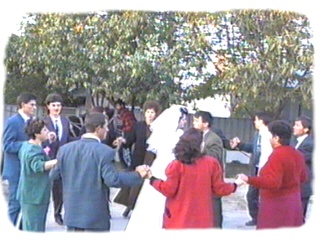 Bride dances in the midle of dancers' circle
Bride dances in the midle of dancers' circle
A wedding tradition still kept in Schela is "Bride's kidnapping".
During the wedding party one the guests kidnaps the bride and hide
her in one room of the premises.
Groom must find his bride by himself.
Otherwise he has to ransom her, offering a prize to kidnapper.
This tradition is meant to teach young husbands to keep always an eye on their wifes.
 Kidnapper Rusin Iulian returning bride back to groom
Kidnapper Rusin Iulian returning bride back to groom

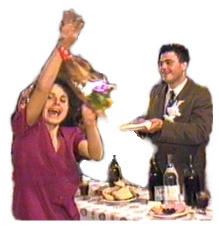
Florica Stroia performing the chicken dance in front of sponsor
Once pork roast dish is served, a person (usually a women) passes among guests' tables.
She carries a roast chicken in her hands and stirs it above her head.
Musicians play a speciffic song while she performes this traditional" chicken dance".
That roast chicken is a symbolic gift offered to sponsors by just married couple.
Chicken dance precedes a new stage in wedding parties: donations' call.
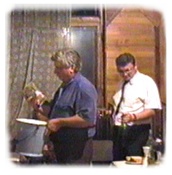
Father-in-low and sponsor collecting donations
When music stops and guests are seated, sponsor passes by every table. He collects donations for the married couple in a bucket or in a fur cap. While collecting money, he calls out how much every guest family contributes for helping the just married couple. Wedding guests offer more or less money, depending on the kinship level they have to young couple. Donations never lower under meal costs (about 30-40 euro, if wedding party takes place in fathers-in-low's courtyards).

When someone is going to die, family send for the priest. They say that priest has to give dying person the last eucharist. After s/he passes away, close relatives wash and dress up the deceased in best cloths s/he had. In Negrea village, an old custom has conserved along time: if a maiden dies, she is burried in a wedding ceremony dress. Usually dead people are kept in open wooden-coffins for 2 nights and 3 days. Coffins lay on tables, inside deceased people's homes.
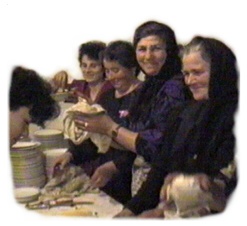
Villagers in Negrea helping at funeral preparations
Women of the late's family cook the food which is to be served after funerals,
at the so called "alms dinner".
Men who used to be close friends to dead person don't sleep those 2 nights
before funerals.
They watch the deceased person.
They drink wine, brandy or boiled wine (on winter time) and remember memories which
include the dead person.
In Negrea village a tradition stands still:
men don't shave for 2-3 months after a dear person's death.
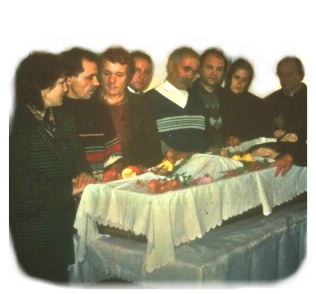
Family watching a deceased person

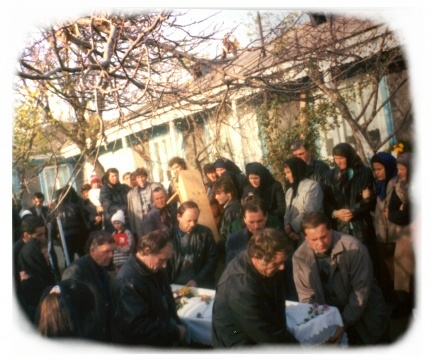
Coffin is carried by men and put into a cart ornated with carpets and flowers all over.
Villagers who appreciated the dead person come and say farewell to him.
They bring flowers and light candles at late's head.
They also present condolences to the family.
Negrea community has still conserved the hired mourners' custom.
Mourners are elderly women who offer their moaning services at funeral ceremonies
in order to give audience the impression that the deceased is most regretted.
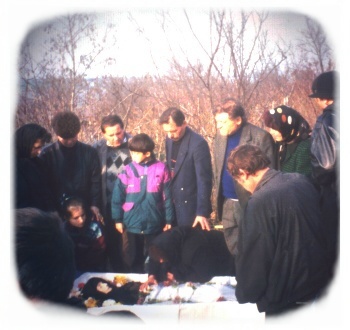
Relatives say farewell to deceased
People who attend funerals wear black suits or have a black banderole on their left arm. Third day after death, at midday, villagers who want to see dead person on his/her last way gather on the street, in front of deceased house. Village priest make a service inside deceased home. Then coffin is carried out in street and put in a cart drawn by oxen. Funeral procession heads towards church. Second funeral service is kept by priest in church. Finnally, last service take place into churchyard, just before closing and burying the coffin.

Churchyards in Schela and Negrea villages are unostentatious. Lack of vegetation makes them look slatternly sometimes. There aren't many tombs/vaults in churchyards. Coffins are usualy buryed directly in the earth. At funerals, wooden crosses are thrust over grave. Subsequently, deceased's families replace these wooden crosses with stone crosses, having engraved the name of dead and period of their life. In Orhodox religion, priests do not keep funeral services to dead who commited suicide.
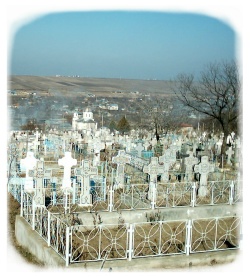
Schela churchyard
After funerals, familly invite to dinner all people who saw the deceased on his last road. This meal is given in memory of the death person and it is called "pomana" (alms dinner). At alms dinners in Schela they usually serve pilaff (boiled chicken and rice) and "coliva" - a traditional desert made by boiled wheaten grains, nut kernel and sugar, all composition adorned with fondant bonbons. Funerals' costs amount to 300 euro, which is sometimes expensive for dead's close relatives as salaries of inhabitants in Schela are about 50 euro/a month.
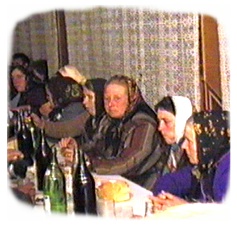
Women in Schela at alms dinner
